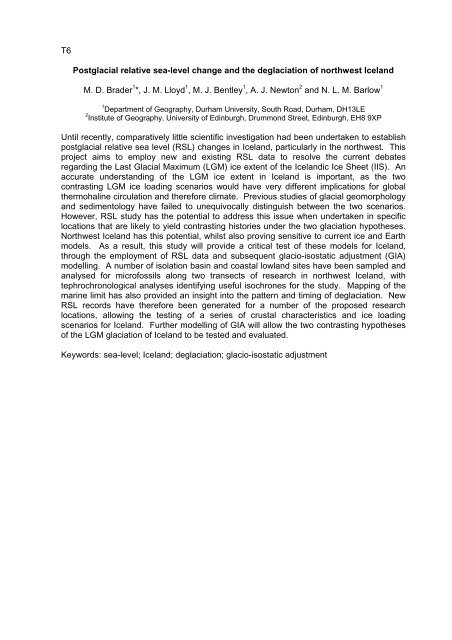The full programme book (PDF) - Royal Geographical Society
The full programme book (PDF) - Royal Geographical Society
The full programme book (PDF) - Royal Geographical Society
You also want an ePaper? Increase the reach of your titles
YUMPU automatically turns print PDFs into web optimized ePapers that Google loves.
T6<br />
Postglacial relative sea-level change and the deglaciation of northwest Iceland<br />
M. D. Brader 1 *, J. M. Lloyd 1 , M. J. Bentley 1 , A. J. Newton 2 and N. L. M. Barlow 1<br />
1 Department of Geography, Durham University, South Road, Durham, DH13LE<br />
2 Institute of Geography, University of Edinburgh, Drummond Street, Edinburgh, EH8 9XP<br />
Until recently, comparatively little scientific investigation had been undertaken to establish<br />
postglacial relative sea level (RSL) changes in Iceland, particularly in the northwest. This<br />
project aims to employ new and existing RSL data to resolve the current debates<br />
regarding the Last Glacial Maximum (LGM) ice extent of the Icelandic Ice Sheet (IIS). An<br />
accurate understanding of the LGM ice extent in Iceland is important, as the two<br />
contrasting LGM ice loading scenarios would have very different implications for global<br />
thermohaline circulation and therefore climate. Previous studies of glacial geomorphology<br />
and sedimentology have failed to unequivocally distinguish between the two scenarios.<br />
However, RSL study has the potential to address this issue when undertaken in specific<br />
locations that are likely to yield contrasting histories under the two glaciation hypotheses.<br />
Northwest Iceland has this potential, whilst also proving sensitive to current ice and Earth<br />
models. As a result, this study will provide a critical test of these models for Iceland,<br />
through the employment of RSL data and subsequent glacio-isostatic adjustment (GIA)<br />
modelling. A number of isolation basin and coastal lowland sites have been sampled and<br />
analysed for microfossils along two transects of research in northwest Iceland, with<br />
tephrochronological analyses identifying useful isochrones for the study. Mapping of the<br />
marine limit has also provided an insight into the pattern and timing of deglaciation. New<br />
RSL records have therefore been generated for a number of the proposed research<br />
locations, allowing the testing of a series of crustal characteristics and ice loading<br />
scenarios for Iceland. Further modelling of GIA will allow the two contrasting hypotheses<br />
of the LGM glaciation of Iceland to be tested and evaluated.<br />
Keywords: sea-level; Iceland; deglaciation; glacio-isostatic adjustment
















